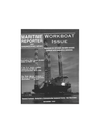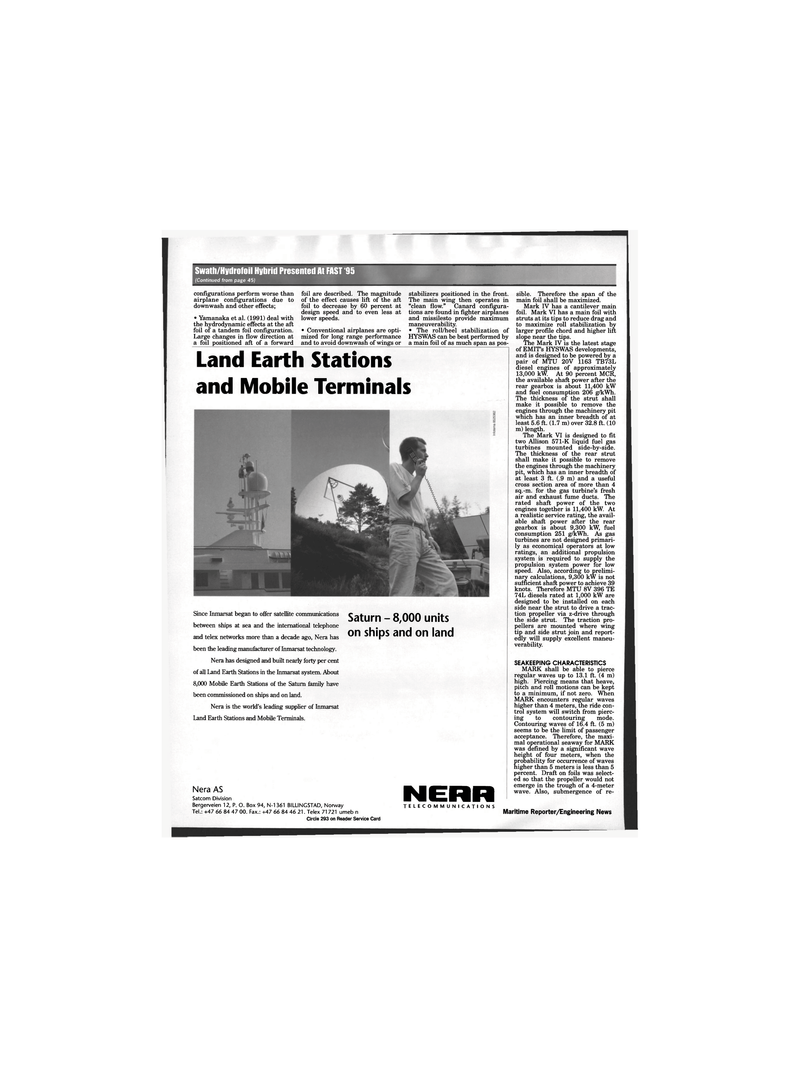
Page 44: of Maritime Reporter Magazine (November 1995)
Read this page in Pdf, Flash or Html5 edition of November 1995 Maritime Reporter Magazine
Swath/Hydrofoil Hybrid Presented At FAST 95 (Continued from page 45)
Nera has designed and built nearly forty per cent of all Land Earth Stations in the Inmarsat system. About 8,000 Mobile Earth Stations of the Saturn family have been commissioned on ships and on land.
Nera is the world's leading supplier of Inmarsat
Land Earth Stations and Mobile Terminals.
Nera AS
Satcom Division
Bergerveien 12, P. O. Box 94, N-1 361 BILLINGSTAD, Norway
Tel.: +47 66 84 47 00. Fax.: +47 66 84 46 21. Telex 71 721 umeb n
Circle 293 on Reader Service Card
NERR
TELECOMMUNICATIONS
SEAKEEPING CHARACTERISTICS
MARK shall be able to pierce regular waves up to 13.1 ft. (4 m) high. Piercing means that heave, pitch and roll motions can be kept to a minimum, if not zero. When
MARK encounters regular waves higher than 4 meters, the ride con- trol system will switch from pierc- ing to contouring mode.
Contouring waves of 16.4 ft. (5 m) seems to be the limit of passenger acceptance. Therefore, the maxi- mal operational seaway for MARK was defined by a significant wave height of four meters, when the probability for occurrence of waves higher than 5 meters is less than 5 percent. Draft on foils was select- ed so that the propeller would not emerge in the trough of a 4-meter wave. Also, submergence of re- 46 Maritime Reporter/Engineering News configurations perform worse than airplane configurations due to down wash and other effects; • Yamanaka et al. (1991) deal with the hydrodynamic effects at the aft foil of a tandem foil configuration.
Large changes in flow direction at a foil positioned aft of a forward foil are described. The magnitude of the effect causes lift of the aft foil to decrease by 60 percent at design speed and to even less at lower speeds. • Conventional airplanes are opti- mized for long range performance and to avoid down wash of wings or stabilizers positioned in the front.
The main wing then operates in "clean flow." Canard configura- tions are found in fighter airplanes and missilesto provide maximum maneuverability. • The roll/heel stabilization of
HYSWAS can be best performed by a main foil of as much span as pos-
Land Earth Stations and Mobile Terminals
Since Inmarsat began to offer satellite communications between ships at sea and the international telephone and telex networks more than a decade ago, Nera has been the leading manufacturer of Inmarsat technology.
Saturn - 8,000 units on ships and on land sible. Therefore the span of the main foil shall be maximized.
Mark IV has a cantilever main foil. Mark VI has a main foil with struts at its tips to reduce drag and to maximize roll stabilization by larger profile chord and higher lift slope near the tips.
The Mark IV is the latest stage of EMIT's HYSWAS developments, and is designed to be powered by a pair of MTU 20V 1163 TB73L diesel engines of approximately 13,000 kW. At 90 percent MCR, the available shaft power after the rear gearbox is about 11,400 kW and fuel consumption 206 g/kWh.
The thickness of the strut shall make it possible to remove the engines through the machinery pit which has an inner breadth of at least 5.6 ft. (1.7 m) over 32.8 ft. (10 m) length.
The Mark VI is designed to fit two Allison 571-K liquid fuel gas turbines mounted side-by-side.
The thickness of the rear strut shall make it possible to remove the engines through the machinery pit, which has an inner breadth of at least 3 ft. (.9 m) and a useful cross section area of more than 4 sq.-m. for the gas turbine's fresh air and exhaust fume ducts. The rated shaft power of the two engines together is 11,400 kW. At a realistic service rating, the avail- able shaft power after the rear gearbox is about 9,300 kW, fuel consumption 251 g/kWh. As gas turbines are not designed primari- ly as economical operators at low ratings, an additional propulsion system is required to supply the propulsion system power for low speed. Also, according to prelimi- nary calculations, 9,300 kW is not sufficient shaft power to achieve 39 knots. Therefore MTU 8V 396 TE 74L diesels rated at 1,000 kW are designed to be installed on each side near the strut to drive a trac- tion propeller via z-drive through the side strut. The traction pro- pellers are mounted where wing tip and side strut join and report- edly will supply excellent maneu- verability.

 43
43

 45
45
